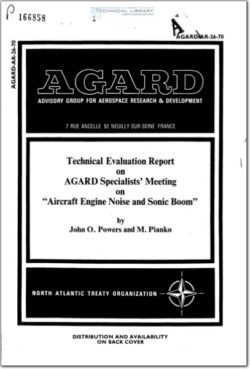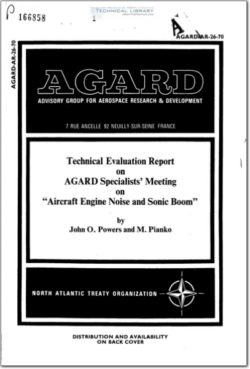AGARD-AR-26-70

- Version
- 174 Downloads
- 742.00 KB File Size
- 1 File Count
- March 8, 2016 Create Date
- March 8, 2016 Last Updated
Aircraft Engine Noise and Sonic Boom

The Joint Meeting of the Fluid Dynamics and the Propulsion and Energetics Panels held in Saint-
Louis, France, from 27 to 30 May 1969, to discuss the problems of aircraft engine noise and sonic boom
was an essential and timely action. During the 1960's, the urban acoustic environmental levels have
been increasing at the alarming rate of roughly one decibel per year and world-wide cooperation will be
required to halt further escalation. The noise sources discussed in the May AGARD Meeting were those
generated because of civil and/or military transportation requirements and, therefore, fall into the
category of "necessary noise". As such, the challenge to the technical community is quite clear; the
transportation modes must be developed while exercising all available acoustic techniques to ensure
that the impact on the acoustic environment is a minimum.
The meeting provided an excellent technical exchange among members of the NATO nations. The
subjects of aircraft noise generation and aircraft noise reduction techniques were discussed in detail.
As could be anticipated, the major manufacturing nations contributed the bulk of the presentations but
active participation was shared by all. Thirteen papers discussed aircraft noise sources mechanisms
and source reduction, while two papers discussed acoustic path control, and three were directed towards
the impact on the receiver. The heavy balance of presentations, toward the subject of the noise source,
is not considered by the present reviewers to represent an optimum approach to the problems of noise
control, for either civil or military air transportation. It is believed that this problem should be
approached in a systematic manner using an appropriate combination of the avenues available to the
acoustician; namely, by source control, path control, and by compensating for the impact on the receiven
Because of this rationale, the evaluation of the aircraft engine noise portion of this AGARD Meeting will
be presented in terms of that approach.
The first paper of the conference by Lilley (1)* was intended to be introductory in nature. The
author, after a brief introduction to aircraft noise related problems, presented a detailed mathematical
discussion of a unified treatment of aerodynamic noise. The e10quence of the mathematical model was
exhibited by its ability to relate to both the problems of sonic boom and jet noise. As is typical of
problems dealing with turbulent fluid flows, recourse to much experimental data is necessary to utilize
the mathematical method to obtain useful results. An assessment of this paper was complicated by the
use of many symbols which were not explicit enough and the mathematic formulations which were not always
distinct or homogeneous.
| File | Action |
|---|---|
| AGARD-AR-26-70 Aircraft Engine Noise and Sonic Boom.pdf | Download |

Comment On This Post